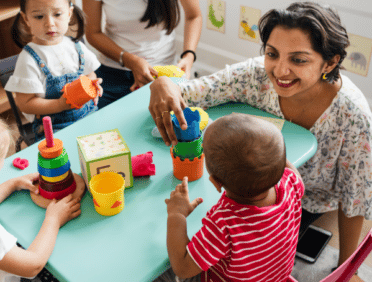Filter by
Safeguarding in the Early Years
The protection of children during their formative years is of the utmost significance in the United Kingdom, where severe regulations and practices are in place to ensure the children’s safety and well-being to the greatest extent possible. The implementation of these procedures guarantees that children from birth to the age of five are given with a secure and supportive environment that fosters their growth and contributes to their development.
Legislative Framework
Key Legislation
The United Kingdom has a comprehensive legal system that is meant to protect children. A number of important pieces of legislation include the Early Years Foundation Stage (EYFS) framework, the Education Act of 2002, and the Children Act of 1989 and 2004. As a result of these rules, all early childhood educators are required to comply with particular safeguarding requirements, which guarantee the safety of the children in their care.
The Role of Ofsted
The Office for Standards in Education, Children’s Services and Skills, also known as Ofsted, is an organisation that is extremely important in the process of inspecting and regulating early years providers. Ofsted is responsible for ensuring that childminders, nurseries, and pre-schools comply with safeguarding regulations.
This gives parents peace of mind that their children are doing well in the care of these establishments.
Safeguarding Policies and Procedures
Creating a Safe Environment
The implementation of comprehensive safeguarding policies and procedures is a requirement for those working in early childhood settings. This includes completing comprehensive background checks on staff members, offering training on safeguarding, and making certain that the physical environment is safe and secure.
Regular risk assessments are carried out in order to identify and eliminate any potential dangers that may be present.
Staff Training and Development
Early-year practitioners absolutely need to participate in ongoing professional development on a consistent basis. Staff members are better able to detect indicators of abuse and neglect, comprehend their obligations, and know how to appropriately respond to concerns when they have received training in safeguarding protocols.
It is important to provide regular updates to ensure that staff members are informed of the most recent safeguarding procedures and regulatory obligations.
Child Protection
Identifying and Reporting Concerns
Knowing how to recognise and disclose concerns about the well-being of a child is one of the most important components of safeguarding. The practitioners who work with children in the early years are educated to recognise changes in behaviour as well as physical symptoms of abuse or neglect.
Keeping to well-defined protocols for reporting these issues to the appropriate authorities is something that they do in order to guarantee that timely and effective action is taken.
Multi-Agency Collaboration
Collaboration between a number of different agencies, such as social services, health experts, and the police, is necessary for effective safeguarding to be carried out. The collaboration of multiple agencies guarantees a comprehensive approach to the protection of children, in which information is exchanged and coordinated actions are performed to ensure the child’s safety.
Parental Involvement
Building Trust with Families
The development of a trustworthy relationship with parents and other carers is of the utmost importance. Early years professionals create close relationships with families, providing them with support and guidance on matters pertaining to child protection. Parents are encouraged to communicate their concerns and take an active role in improving their child’s safety and well-being when communication channels are open.
Educating Parents
Educating parents about the importance of safety is also very important. Information is provided in early years settings on how to recognise the indications of abuse, how to appreciate the necessity of safeguarding measures, and how to know how to seek help. Providing parents with the knowledge they need to succeed improves the whole framework for protecting children.
Frequently Asked Questions (FAQs)
When it comes to early childhood education, the term “safeguarding” refers to a wide range of methods and procedures that are intended to protect children from a variety of forms of harm, such as abuse, neglect, exploitation, and maltreatment. It entails the creation and upkeep of an atmosphere in which children are made to feel cherished, safe, and secure.
Among these are the implementation of efficient regulations for the protection of children, the execution of exhaustive background checks on staff members and volunteers, and the guarantee that the physical facilities are risk-free and devoid of any potential hazards.
Safeguarding entails ensuring that children’s voices are heard and that they are listened to, as well as supporting the mental and emotional well-being of children. The objective is to give a holistic approach to the care and protection of children, with the intention of ensuring that their whole development takes place in an atmosphere that is both safe and supportive.
Due to the fact that young children are particularly vulnerable and dependent on adults for their safety and well-being, safeguarding is of the utmost importance in early years settings. Effective safeguarding procedures help protect children from potential damage and support their physical, emotional, and psychological development.
The implementation of certain safeguards is the means by which this objective can be achieved. Children are afforded the opportunity to learn, discover, and develop their sense of self-assurance when they are in an environment that safeguards them.
To add insult to injury, safeguarding is an absolute must in order to build trust when it comes to the relationship between children, their parents, and their teachers.
It provides parents with the peace of mind that their children are in a secure environment and contributes to the maintenance of the educational institution’s professional integrity. Safeguarding methods that are effective also help identify and resolve problems at an early stage, which helps prevent children who may be at risk from experiencing negative results in the long run.
Among the fundamental tenets of safeguarding in early childhood education are the following: prevention, protection, support, empowerment, and accountability.
Prevention is the process of taking preventative actions to ensure that hazards are reduced to a minimum. These efforts include putting in place rigorous recruitment standards and conducting risk assessments on a regular basis.
Protection guarantees that prompt action is taken in the event that a child is in danger, which may include reporting concerns to the relevant authorities. The provision of vital help to children and their families, the addressing of their particular requirements, and the promotion of their well-being are the primary goals of support work.
Children with empowerment are more likely to voice their concerns, and they are also more likely to advocate for their rights and autonomy. As part of the accountability process, it is necessary to make certain that all employees receive sufficient training, that there are well-defined policies and procedures in place, and that they are routinely reviewed and updated.
When taken as a whole, these principles contribute to the formation of an all-encompassing safeguarding framework that places an emphasis on the protection and satisfaction of children.
In early years settings, the responsibility of safeguarding is shared by all members of the staff, including volunteers and managers, and each individual plays an important part in this task. It is imperative that every single person who works in the setting be watchful and proactive in order to guarantee the well-being and safety of the children.
The organization is required to appoint a Designated Safeguarding Lead (DSL). This individual is responsible for overseeing all safeguarding matters, ensuring that policies are adhered to and concerns are addressed in a timely manner. It is the responsibility of the DSL to ensure that continual training and development in safeguarding procedures are carried out, as well as to provide support and direction to staff members and to coordinate with relevant external organisations.
Every member of the staff should be familiar with the safeguarding policies and procedures, and they should be informed of what to do in the event that they have concerns regarding the safety of a child. The use of this collaborative method guarantees the establishment of a comprehensive and efficient protection system.
A number of significant pieces of legislation that govern safeguarding in the early years make up the United Kingdom’s strong legal framework for protecting children.
Providing extensive rules for the care and protection of children, the Children Act of 1989 and the Children Act of 2004 both emphasise the importance of the child’s welfare as being of the utmost importance.
Educators are required to protect and advance the well-being of children, as outlined in the Education Act of 2002, which also specifies the responsibilities of early childhood educators and schools.
A legal foundation for early years services is established by the Childcare Act of 2006, which also defines quality requirements for education and care.
In 2018, the Working Together to Safeguard Children Act provided statutory advice on inter-agency working to safeguard and promote the welfare of children. This policy aims to ensure that various organisations effectively collaborate with one another.
A comprehensive set of standards for schools and colleges is included in Keeping Children Safe in Education 2023. These requirements emphasise the importance of maintaining a watchful and ongoing approach to child protection. All of these pieces of law work together to guarantee that safeguarding procedures are standardised, efficient, and legally obligatory in every early childhood environment.
Early years settings are required to adopt a complete safeguarding strategy in order to guarantee compliance with the legislation governing child protection responsibilities. A clear and comprehensive set of safeguarding policies and procedures that are routinely reviewed and updated need to be developed and maintained in order to accomplish this.
A comprehensive training programme on safeguarding practices should be provided to the staff. This training should cover topics such as recognising the indications of abuse, comprehending the procedures for reporting concerns, and being aware of their duties and responsibilities.
The designation of a Designated Safeguarding Lead (DSL) is absolutely important in order to fulfil the objective of supervising safeguarding practices and ensuring that they are effectively implemented. It is advised that frequent audits and inspections be carried out in order to identify and address any faults or holes that may exist within the safeguarding system.
This helps to develop a solid support network and ensures that issues regarding safeguarding are swiftly addressed. Additionally, keeping open lines of contact with parents, guardians, and other organisations is beneficial. It is a never-ending process that calls for vigilance, effort, and continuing progress in order to ensure compliance with safeguarding rules.
Employees working in early childhood education are required to receive extensive training in child protection, which must be updated on a regular basis to ensure that they are up to speed on the most recent regulatory requirements and best practices.
Fundamental parts of safeguarding should be covered in the initial training, such as being able to identify indicators of abuse and neglect, being familiar with the safeguarding regulations of the setting, and being able to report concerns.
Specialised training should be provided to the Designated Safeguarding Lead (DSL) in order to equip them with the skills necessary to effectively lead safeguarding initiatives. Every member of the staff has to be provided with opportunities for ongoing training and professional development.
These opportunities should include access to appropriate materials, workshops, and refresher courses. This ongoing education ensures that staff members are well-versed in the most recent advances in safeguarding policies and laws, as well as that they are ready to respond effectively to any concerns regarding personnel safety.
Signs of abuse or neglect in young children can appear in a variety of ways, including physical, emotional, and behavioural manifestations. Children could come with inexplicable injuries, bruising, burns, or fractures due to their physical condition.
Inadequate cleanliness, deficits in diet, or untreated medical issues could be the cause of the symptoms that they present. Children who are going through some kind of emotional discomfort may demonstrate a sudden change in their conduct, such as being withdrawn, hesitant, or excessively violent. This may be the case when they are suffering some kind of emotional anguish.
They may exhibit a phobia of particular people or surroundings, or they may demonstrate an aversion to interactions that include physical contact. Developmental delays, relapse to earlier behaviours (such as bedwetting), or demonstrating knowledge or interest in sexual behaviours that are improper for their age are all examples of behavioural symptoms that may be present.
The personnel must be watchful and observant in order to identify any indicators that may indicate a child is being abused or neglected. It is of the utmost importance that they do this. Early detection and intervention are essential components in the process of safeguarding the wellbeing of the child.
If the staff has reason to believe that a kid is being mistreated, they should adhere to a response strategy that is both explicit and systematic. At first, they should pay attention to what the child has to say without showing any signs of surprise or disbelief. They should also reassure the youngster that they are safe and that they have made the correct decision by speaking out.
It is the responsibility of the staff to avoid making promises that they are unable to follow, such as guaranteeing perfect confidentiality. As an alternative, they should explain that in order to assist in the protection of the child, they are required to communicate the information with the proper individuals.
There should be rapid documentation of the child’s disclosures, observations, and any other pertinent information. These records should be detailed and accurate. After that, the concern needs to be conveyed to the Designated Safeguarding Lead (DSL) as soon as possible.
Following an evaluation of the circumstances, the DSL will, if deemed necessary, send the matter to the children’s social care department of the local authority or to the police. This will ensure that the child receives the right support and protection during the entire process. The child’s safety and well-being should remain the top priority throughout the entire procedure.
In early years settings, the designation of the Designated Safeguarding Lead (DSL) is of utmost importance because it serves as the primary point of contact for all concerns pertaining to safeguarding. It is the responsibility of the DSL to make certain that the safeguarding policies and procedures are adequately implemented and adhered to.
Among these are the provision of direction and assistance to staff members, the management of referrals, and communication with external organisations such as the children’s social care department of the local authority and the police.
Because the DSL is responsible for ensuring that the standards of confidentiality and data protection are adhered to, it is imperative that each and every safeguarding concern and action that has been taken be thoroughly documented.
They are responsible for overseeing the implementation of safeguarding training, which ensures that all employees are equipped with the information and skills necessary to recognise and respond to cases of safeguarding.
The DSL plays an essential role in ensuring that safeguarding procedures are adhered to on a consistent basis and contributing to the preservation of a secure environment for children.
When it comes to early childhood settings, the creation of a safe environment requires a multidimensional strategy that takes into account not just physical safety but also emotional and psychological safety.
On a physical level, the environment needs to be safe and devoid of any potential dangers, and there ought to be routine safety inspections and risk assessments carried out in order to identify and resolve any potential threats.
Children ought to have the experience of being supported and respected on an emotional level, and healthy relationships ought to be established between the staff, the children, and their families.
Staff members should receive training to identify and respond to the emotional needs of children in order to create an environment that is both loving and welcoming to all. Having norms and expectations that are both clear and consistent helps youngsters feel more stable and secure in their environment.
It is of the utmost importance to foster an environment that is open and communicative, one in which children are at ease expressing their concerns and experiences. It is possible to further improve the safety and well-being of children by involving their parents and guardians in the activities that take place in the setting, as well as by providing them with information and support.
The process of reporting a concern regarding child protection in the early years requires a method that is both clear and structured. This is done to guarantee that concerns are addressed in a timely and efficient manner. The Designated Safeguarding Lead (DSL) should be notified of any concerns as soon as feasible, and this should be done immediately.
The member of staff who is reporting the concern is obligated to offer a comprehensive description of their observations, as well as any disclosures made by the child and any other pertinent information for consideration.
After that, the DSL will evaluate the concern and decide whether it calls for additional inquiry or whether it should be referred to different organisations, such as the children’s social care department of the local council or the police.
It is necessary to keep documents that are both accurate and discreet on the issue and any measures that were taken in response to it. It is also the responsibility of the DSL to make certain that the child is protected and supported during the entire process.
Training on a consistent basis and clear communication regarding the reporting processes are both required in order to guarantee that every member of the staff is self-assured and competent to handle problems with safeguarding in an appropriate manner.
At the very least once a year, safeguarding policies in early childhood education settings ought to be under scrutiny to guarantee that they continue to be relevant and efficient. By conducting regular reviews, organisations are able to incorporate any changes that may occur in policies, guidelines, and best practices.
There should also be a review of the safeguarding policies after any occurrences or issues about safeguarding in order to identify any gaps or areas that could use improvement. It is possible to gain useful insights and contribute to the process of ensuring that the policies are comprehensive and successful by involving staff members, parents, and outside experts in the review process.
To ensure that early years settings continue to uphold a high quality of child safety and are able to adapt to new challenges and advances, continuous monitoring and assessment of safeguarding procedures, in conjunction with regular policy reviews, are essential.
Parents and guardians play an essential part in the process of safeguarding their children since they are actively involved in their children’s education and other aspects of their well-being. There is an absolute requirement for effective communication between early childhood facilities and parents in order to facilitate the exchange of information and concerns that may have an impact on the safety of a child.
It is crucial to encourage parents to take part in the seminars and training sessions on safeguarding that the setting offers. This will help parents have a better awareness of the safeguarding procedures that are in place and the ways in which they may contribute to the protection of their child.
The parents ought to be familiar with the safeguarding regulations and processes of the setting, and they ought to be aware of how to report any concerns that they might have. This results in the development of a collaborative approach to safeguarding, which guarantees that children are protected and cared for in a consistent manner both at home and in institutional settings.
The development of strong, trustworthy connections between early childhood educators, parents, and guardians is a key component in the process of promoting this approach.
Providing individualised approaches that take into account the specific vulnerabilities and requirements of children with special educational needs (SEN) is an essential part of providing support for safeguarding these children.
These early years settings should make certain that their safeguarding policies are inclusive and take into consideration the particular dangers and difficulties that children with special educational needs (SEN) face.
Those who work with children who have special educational needs (SEN) should have specific training in order to be able to identify and respond correctly to the signs of abuse and neglect in these children, who may express their suffering in a different way. It is vitally necessary to collaborate with parents, carers, and specialists from the outside, such as special educational needs coordinators and healthcare providers, in order to establish comprehensive support plans.
The individual needs of each child, as well as strategies for fulfilling those needs and standard operating procedures for child protection, should be outlined in these plans.
Providing children with special educational needs (SEN) with access to suitable communication aids and support systems enables them to voice their concerns and experience a sense of safety within the surrounding environment.
In early childhood settings, both volunteers and visitors are required to adhere to stringent safeguarding regulations in order to guarantee the children’s safety and well-being.
Regular volunteers ought to be subjected to exhaustive background investigations, which should include checks from the Disclosure and Barring Service (DBS), in order to guarantee that they are eligible to work with children.
A safeguarding induction should be provided to all visitors and volunteers, including an overview of the organisation’s safeguarding policies and processes, as well as expectations for behaviour and instructions on how to report problems.
Volunteers and guests should be under constant supervision at all times, and they should never be left alone with children. All of the sign-in and sign-out logs, as well as accurate records of the attendance of visitors and volunteers, should be kept.
These steps contribute to the establishment of a safe and secure environment by ensuring that the only people who are permitted to deal with the children are those who have been screened and trained.
The handling of allegations against members of staff requires a process that is transparent, unbiased, and comprehensive in order to guarantee the protection of children and the equitable treatment of staff members. It is imperative that the Designated Safeguarding Lead (DSL) be notified as soon as an allegation is received.
After conducting an inquiry into the accusation, the DSL will evaluate it and, if necessary, forward it to the local authority designated officer (LADO) for further investigation. It may be necessary to suspend the staff member who was involved during the investigation in order to protect the children and maintain the credibility of the procedure.
It is essential to keep precise records of all the actions taken and decisions made in order to carry out an investigation that is both extensive and objective. It is absolutely necessary to uphold secrecy throughout the entire process in order to protect the personal information of everyone who is participating.
It is absolutely necessary to maintain open and honest contact with the staff member, the parents, and the appropriate authorities in order to guarantee responsibility and transparency.
Documenting the findings of the investigation and taking any necessary measures to prevent incidents of this nature from occurring again in the future is essential in order to reduce the likelihood of similar accidents occurring in the future.
The process of conducting a safeguarding risk assessment entails carefully identifying potential threats to the safety and well-being of children and putting into action steps to reduce the impact of these threats.
The first step in the procedure involves conducting a thorough assessment of the physical environment, which includes a thorough examination of the buildings, equipment, and outdoor areas, in order to detect any potential dangers.
When doing the evaluation, it is important to take into consideration the staffing levels, qualifications, and training level of the staff. This is done with the intention of ensuring that there are sufficient and competent workers to monitor the safety of children. It is vital to undertake a review of the operating procedures and policies in order to identify any areas of weakness or potential for improvement that may exist.
A plan should be prepared to manage and mitigate the risks that have been discovered once they have been recognised. This plan should include timetables for implementation and tasks that are given to specific members of the staff.
Reviewing and updating the risk assessment on a regular basis ensures that it continues to be applicable and effective in addressing new and emerging risks. It is possible to gain useful insights and contribute to the creation of a safer environment for children by recruiting staff members, parents, and outside experts to participate in the risk assessment process.
Educating children, parents, and staff members about the dangers that are involved with using the internet and instructions on how to manage these dangers in a secure manner is an important part of promoting online safety for young children in early childhood settings.
Clear norms and standards for the use of technology should be implemented in the settings in order to guarantee that all devices are protected and that they have sufficient filters and controls in place. This would provide kids with skills that are age-appropriate for using the internet in a responsible and safe manner. Educators ought to incorporate lessons on internet safety into the curriculum.
It is possible for parents to provide better support for their children while they are at home if they are given the opportunity to engage in workshops and are given tools that teach them how to protect their children while they are online.
The personnel should receive training on internet safety in order to guarantee that they are aware of the most recent risks and best practices in the field.
It is helpful to promote a culture of safety and alertness by encouraging children to report any concerns or inappropriate content they encounter online and fostering open communication about their experiences while using the internet.
Practitioners of early childhood education have access to a wide range of resources that can assist them in remaining current on the most effective safeguarding methods. Publications issued by the government, such as “Keeping Children Safe in Education” and “Working Together to Safeguard Children,” offer crucial direction and fulfil the provisions of the law.
Professional organizations like the National Society for the Prevention of Cruelty to Children (NSPCC) provide training programs, workshops, and online resources specifically created to safeguard children in early childhood settings.
Local authorities frequently make additional training and support, including access to safeguarding experts and networks, available. E-learning modules and online platforms provide practitioners with learning possibilities that are both convenient and flexible.
Practitioners are able to remain informed about the most recent advancements in safeguarding by participating in professional networks and forums, where they may also discuss difficulties, share their experiences, and express their perspectives.
By regularly assessing updates from safeguarding bodies and incorporating new practices into the setting’s policies and procedures, practitioners can continue to receive the training they need to protect children in an effective manner.














